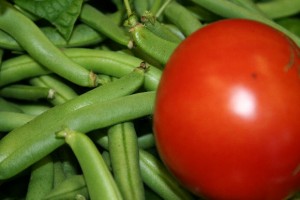 |
| Tomatoes and green beans from the garden |
Last night I tackled some vegetable garden chores and reflected on both homesteading and self sufficient living. I pulled up the insect infested squash, cucumbers and zucchini; they’re ruined, but I do have a bowl full of cucumbers begging to be made into cold cucumber soup, a delicacy I love each summer.
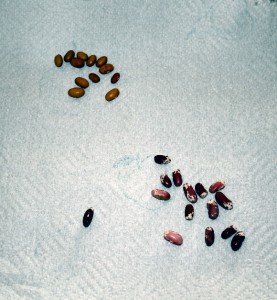 |
| Dried beans |
I harvested dried bean pods and thought about what it would take to grow food for completely self sufficient living. I planted one 4′ x 8′ bed with beans solely for drying – Dutch Brown and Jacob’s Cattle. Dutch browns make baked beans, and Jacob’s Cattle supposedly keep very well. After all my hard work, this is what I have so far –
Maybe enough for one meal?
Then I dug spuds. Potatoes. This is the first year I’ve grown potatoes. After a spring of plentiful rain, the drought and heat came. I grew Yukon Gold potatoes from seed potatoes my neighbor Mel gave me and Russets from a $2.50 bag purchased at the local discount store, Roses.
Here’s what I harvested so far – about 10 pounds of potatoes. The biggest ones are the size of baseballs, but most are the size of ping pong balls. There are about a dozen plants still green and living in the potato bed, so I left them there.
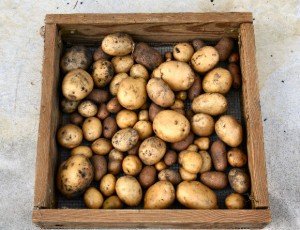 |
| First potato harvest on drying tray |
I harvested herbs last night and placed a tray of catnip in the garage to dry. Pierre doesn’t like fresh nip, so it’s safe until dried. Then all bets are off.
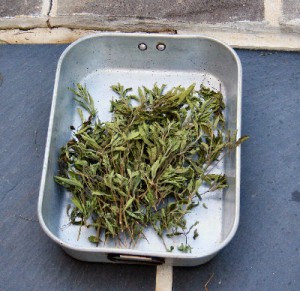 |
| Herbs solar drying |
Here’s what I realized from spending two hours last night harvesting and shelling beans, harvesting onions and cucumbers, weeding vegetable beds, throwing tomatoes with blossom end rot over the fence, pulling up bolted lettuce, and digging potatoes until it got too dark to see: homesteading is hard work.
Yeah, I know: “Duh!” But seriously, did you ever consider as you pile your shopping cart full of Bush’s baked beans, canned peas, plastic-wrapped loaves of bread and cartons of milk the sheer WORK that went into producing the food you buy so casually?
Self sufficient living sounds great on paper, but what do you do about droughts? I have a garden sprinkler on a tripod, but I don’t like tapping into the household well too much. When you realize that if you drain your well you’re going to have to pay thousands and thousands of dollars for a new one, not to mention dig up your lawn and garden, you treat water like the precious commodity it is.
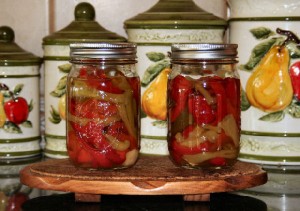 |
| Vegetables pickled for the pantry |
I look at the beans and think about our pioneer ancestors for whom homesteading was a necessity, not a luxury. Those dried beans formed the winter staple diet. The beets I pickled and canned last month, the peppers waiting to be canned along with things like the onions and potatoes dug last night, the beans drying in the kitchen – if I were truly homesteading, I would have to survive on this. Those herbs that looks so picturesque in the garden would be my medicine; the flowers I love to look at would supply medicine too, the Echinacea roots. The peaches in the orchard would need to be canned, dried, preserved to feed my family.
 |
| Not just a pretty face; if I were homesteading, this would be my medicine. |
Could I actually feed my family from the garden like a pioneer woman? Yes, I could…but it’s true; our ancestors did indeed work sunup to sundown. Think about tending the gardening, harvest, drying, canning, preserving the food. Think about sewing clothing and cleaning the house by hand. Think about it.
 |
||
| Peach in our orchard today. The mesh keeps deer from the lower part of the tree. |




